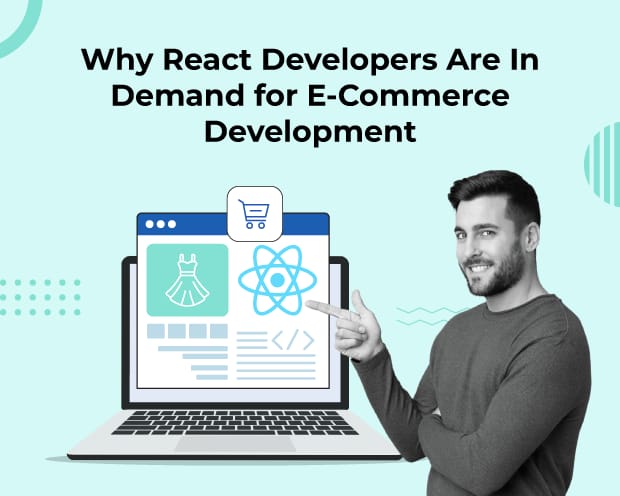E-commerce has become a fast-moving battleground where user experience decides who wins the sale. As a CTO, you know that milliseconds in page load time or friction in checkout flow can directly impact conversions. That’s where React makes a difference.
React helps teams build interactive, component-driven storefronts that can approach native-app smoothness when paired with optimized rendering and caching strategies. Your developers can reuse logic, accelerate development, and maintain a consistent design across hundreds of pages. This is possible due to React’s component-based architecture. With frameworks like Next.js and Shopify Hydrogen, React has become a preferred choice for building the frontend layer in modern headless commerce architectures.
This blog explores the benefits of React for e-commerce and the trends increasing the demand for React developers.
The Evolving E-Commerce Frontend Landscape
In the past few years, the e-commerce industry has undergone a profound shift. Gone are the days of static product pages and slow reloads. Nowadays, users expect dynamic experiences that feel instant and personal. Customers now expect storefronts to be fast, responsive, and visually consistent across every device.
Traditional monolithic systems can’t deliver that level of speed or flexibility anymore. However, this issue can be addressed by adopting modern frameworks like React. With React, your teams can create modular, reusable components that scale easily, support real-time interactions, and integrate well with APIs and headless platforms.
React in E-Commerce Development: What are the Benefits?
React brings engineering efficiency and long-term sustainability to your digital storefront. Let’s look at how it does that in very practical terms:
1. Component Reusability and Faster Iterations
React’s component-based structure is one of its biggest advantages for e-commerce. Each button, product tile, or cart summary exists as an independent unit. You can reuse these units across your entire site. When your design team updates a product card, the change reflects everywhere.
This translates to faster rollouts, smaller QA cycles, and cleaner codebases. You can run multiple store variants or localized versions without rewriting core elements.
2. Performance and SEO Advantage
Speed and visibility are non-negotiable for an online store. React’s Virtual DOM and diffing algorithm enhance rendering efficiency, though actual performance gains depend on how components are structured. With frameworks like Next.js that enable Server-Side Rendering (SSR) and Static Site Generation (SSG), e-commerce sites can achieve faster load times and better SEO discoverability.
Since pages load faster, bots crawl them better. It also urges the user to stay on the page for a fair amount of time. Apart from performance gains, you also get a measurable revenue impact.
3. Seamless Integration with Headless Commerce
As more businesses move to headless architectures, React has become the natural choice for the frontend layer. It works seamlessly with platforms like Shopify Hydrogen, BigCommerce, and Commerce.js. This approach to headless e-commerce lets you decouple your frontend from the backend and innovate independently on each side.
You can test new customer flows or promotions on the frontend without touching your commerce logic. You can even integrate multiple data sources – product APIs, CMS, analytics – into one unified user experience.
4. Scalable Architecture for Growth
React applications scale as your catalog grows. Your architecture remains maintainable whether you expand from 1000 to 100,000 SKUs or introduce new verticals. React’s component isolation supports microfrontend architectures, enabling independent team deployments with minimal coupling and reduced risk of breaking global features.
5. Smooth Omnichannel Experience
React enables consistency across web, mobile, and in-store digital experiences through React Native and React Native Web. React Native and React Native Web share similar component models, allowing partial reuse of business logic and UI patterns across web and mobile. This makes development more efficient and also convenient.
6. Easier Testing and Quality Assurance
Data relating to cart updates, promotions, stock changes, and personalization logic flows constantly in e-commerce. React handles this complexity with predictable state management libraries. Redux Toolkit efficiently manages client-side state, while React Query handles server-side state synchronization. Together, they help maintain consistent cart and pricing data across reloads and sessions.
7. Flexibility for Third-Party Integrations
With React’s open architecture, you can integrate analytics, payment gateways, chatbots, and personalization engines easily. React’s modular structure allows smooth integration of APIs like Stripe, Google Tag Manager, or Algolia through context providers and hooks while minimizing architectural changes.
8. Ideal for Personalization and E-commerce UI Design
Personalization drives retention, and React makes it efficient. Its reactive rendering model lets you serve context-aware UIs without reloads. Integrating AI-driven personalization engines becomes easier because React handles DOM updates efficiently. This enables users to see relevant offers instantly, which eventually improves both engagement and lifetime value.
9. Excellent Support for Progressive Web Apps (PWAs)
React can power Progressive Web Apps (PWAs) using tools like Workbox or Next.js PWA plugins. This enables offline caching, background sync, and push notifications for mobile-first markets.
10. Ecosystem Strength and Developer Velocity
React’s ecosystem is massive. From Redux Toolkit and React Query to Tailwind CSS and Zustand, developers have access to a mature library network that cuts down build time. Your team can focus on optimizing business logic and improving UX.
This enables you to release features within a short period and also simplifies hiring. The global React talent pool is large, well-documented, and constantly growing. As a result, there are fewer onboarding delays and better maintainability across teams.
Why CTOs Prefer React Developers for E-Commerce Teams
You need a frontend that scales fast, adapts easily, and delivers seamless performance across every device. React developers bring exactly that mix of agility and precision to e-commerce projects. They help you build future-ready interfaces without locking you into rigid systems or large maintenance cycles.
Here are the key reasons why hiring React developers can be a strategic advantage for e-commerce development:
1. Cross-Functional Agility
React developers can move fluidly between web, mobile, and progressive web apps. This allows you to reuse logic and components. It cuts down development time and ensures brand consistency across all touchpoints.
2. Future-Readiness with Next.js and Edge Architectures
With Next.js, React developers can implement server-side rendering, static generation, and edge deployments. This improves load times, supports global scalability, and enables faster A/B testing and rollouts.
3. Efficient Team Structures
React’s modular nature lets smaller teams achieve more. You can build, update, and test features independently without disrupting other parts of the site.
4. Long-Term Maintainability
React’s component-based approach makes updates predictable and controlled. As your catalog or product mix grows, you can scale smoothly without rewriting your entire frontend.
Emerging Trends Elevating React Developers’ Demand
Here’s what’s shaping the next wave of demand for skilled React developers:
- AI-Driven Personalization: React seamlessly integrates with AI APIs and recommendation engines. It delivers dynamic, user-specific content that boosts engagement and conversions.
- 3D and Interactive Product Visualization: Libraries like React Three Fiber are making immersive, 3D product experiences mainstream.
- TypeScript Adoption for Enterprise-Grade Codebases: More teams are shifting to TypeScript with React to ensure type safety, scalability, and better collaboration in large multi-developer environments.
- GraphQL and API-First Commerce: Combining React with GraphQL allows faster data fetching and smoother interactions. This is especially critical in headless commerce setups.
- React Server Components (RSC) and Edge Rendering: The rise of React Server Components (now production-ready in Next.js 14+) marks a major leap for React in e-commerce. It allows partial server-side rendering and client hydration efficiency. This drastically improves load performance and SEO. Similarly, Edge Rendering brings pages closer to users globally, thereby reducing latency and improving site responsiveness.
- React Native for Unified Commerce: Businesses are extending React’s ecosystem into mobile commerce. This helps them in maintaining consistency across web and mobile with shared components.
Conclusion
The e-commerce realm is never stable, which makes it necessary for your frontend to keep up. React gives you that edge. It combines flexibility, speed, and scalability so your teams can deliver smooth, high-performing user experiences. The growing demand for skilled React developers isn’t just about code but more about creating a future-ready e-commerce foundation.


